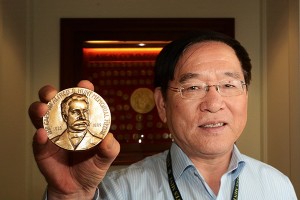by the Office of Corporate Communications
September 9, 2015

A materials engineer in the manufacturing division at Mint Headquarters in Washington, D.C., has received the highest honor in the lubrication and tribology field.
In May, Dr. Tony Ying was presented the 2015 Captain Alfred E. Hunt Memorial Award for a paper titled “Nanotribology Application In The Coining Industry – The Thermodynamic Model for Surface Chemical Reaction,” at the 70th annual meeting of the Society of Tribologists and Lubrication Engineers in Dallas.
The award is one of six given annually since 1949 for excellence in technical publishing, recognizing the STLE member or members for writing the best paper in lubrication or an allied field.
Tribology is a branch of mechanical engineering and materials science concerned with interacting surfaces in relative motion. It includes the study and application of the principles of friction, lubrication and wear.
“This model modified the Arrhenius equation for chemical reaction, which appears in all chemistry textbooks,” Ying said. “My contribution is that with the surface friction, this equation must be modified by the frictional work dissipated on the surface. I used this model to guide the work to generate a monomolecular layer on coin blank surfaces. I was so surprised and really happy to get this award.”
He described the timeline of the research and the resulting paper.
“It took me about three years of continually thinking about how chemicals react with a solid surface when two surfaces rub each other in a burnishing process, and I read many technical papers to find the clues to mathematically describe the process,” Ying said. “Meanwhile, I tried to link the understanding from the basic research with the step-by-step coining practices. From 2006 to 2010, we tried to implement the monomolecular layers on blanks. We failed more than 100 times. For any technology improvement, success is only once; the failures are countless. The key is to try to learn something from failure.”
Ying said his study led to using a metal burnishing formulation that provides lubrication, corrosion inhibition, and metal protectant for the blank burnishing process. The formula calls for getting dimethyl didecyl ammonium bicarbonate to react with benzotriazole. That technical-sounding process, currently used in production of circulating nickels, dimes, quarters and dollars, has a parallel in everyday life.
“The effect is similar to laundering clothes in a washing machine,” Ying said. “In a horizontal washer, when the barrel is rotating, the clothes rotate with it. At certain angle, the clothes fall down; gravity makes their fibers rub each other in the chemical solution. The rubbing movement makes the chemical reaction between the fibers and the detergent much faster than if the clothes were just immersed in the same solution.”
Ying explained how the production improvement helps cut Mint costs.
“Coining dies are expensive. This change increases circulating die life three times. After the new process was implemented in the production line, in 2010 at Philadelphia and 2012 in Denver, the Mint saved $2 million each year.”
He said multiple Mint products stand to benefit.
“Based on the model, we could use the lubricant for the blank burnishing process,” Ying said. “This model can be used in our production application, and it is a common rule for chemical reactions on a rubbing surface.”
See more Inside the Mint articles


